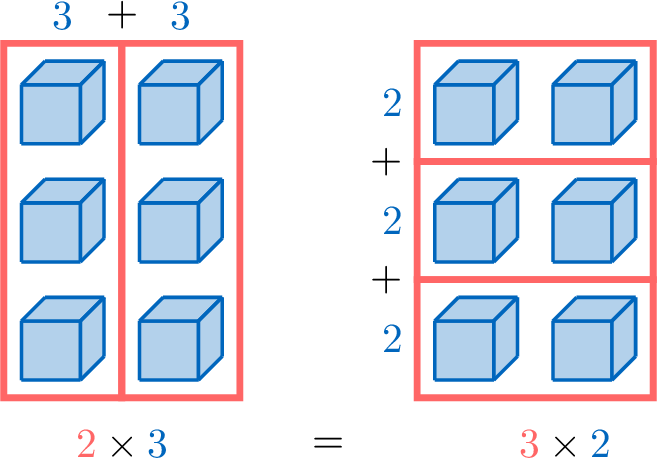Multiplication
Multiplication is a very important concept in mathematics. It’s a way of adding the same number together many times.
Definitions
Louis loves apples and eats exactly 2 apples every day. He never misses a day because he knows how healthy and tasty apples are.


If we want to know how many apples Louis eats in a week (7 days), we add 2 apples for each day:$$\textcolor{colorprop}{2}+\textcolor{colorprop}{2}+\textcolor{colorprop}{2}+\textcolor{colorprop}{2}+\textcolor{colorprop}{2}+\textcolor{colorprop}{2}+\textcolor{colorprop}{2}$$We find \(14\) apples. In this chapter, we will introduce multiplication to make it quicker and easier. When we say \(\textcolor{colordef}{7}\) groups of \(\textcolor{colorprop}{2}\) apples, we can write it as \(\textcolor{colordef}{7}\times \textcolor{colorprop}{2}\). The symbol \(\times\) means multiplied by or times.$$\textcolor{colordef}{7}\times \textcolor{colorprop}{2}=\textcolor{colorprop}{2}+\textcolor{colorprop}{2}+\textcolor{colorprop}{2}+\textcolor{colorprop}{2}+\textcolor{colorprop}{2}+\textcolor{colorprop}{2}+\textcolor{colorprop}{2}$$
Definition Multiplication
Multiplication is the process of repeated addition. When we multiply, we calculate the total by adding a number to itself a specified number of times.
Multiplication can be represented in several ways:
Multiplication can be represented in several ways:
- Numbers: $$\textcolor{colordef}{4}\times \textcolor{colorprop}{3}=\textcolor{olive}{12}$$
- Groups: $$\textcolor{colordef}{4}\text{ groups of }\textcolor{colorprop}{3}=\textcolor{olive}{12}$$
- Repeated addition: $$\textcolor{colorprop}{3}+\textcolor{colorprop}{3}+\textcolor{colorprop}{3}+\textcolor{colorprop}{3}=\textcolor{olive}{12}$$
- Words:
four times three equals twelve - Items:
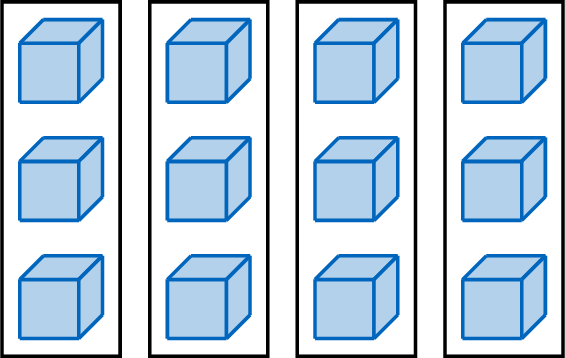
- Part-whole model:
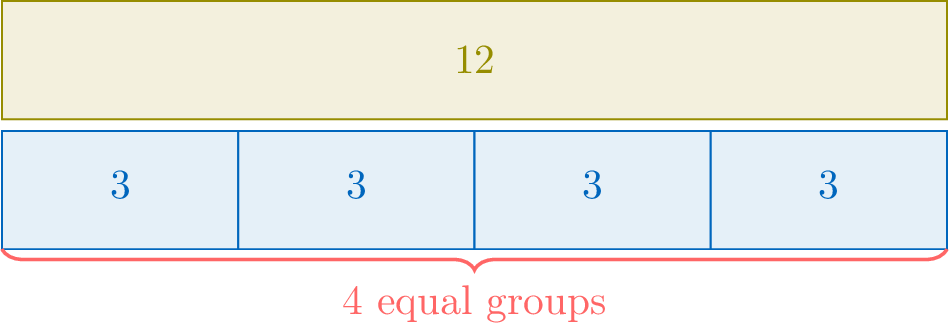
Example
Write the repeated addition \(\textcolor{colorprop}{5}+\textcolor{colorprop}{5}+\textcolor{colorprop}{5}\) as a multiplication.
\( \textcolor{colorprop}{5}+\textcolor{colorprop}{5}+\textcolor{colorprop}{5}=\textcolor{colordef}{3}\times \textcolor{colorprop}{5}\)
In Number Line
Let's consider the multiplication: \(\textcolor{colordef}{4} \times \textcolor{colorprop}{3}\) that is$$\textcolor{colorprop}{3}+\textcolor{colorprop}{3}+\textcolor{colorprop}{3}+\textcolor{colorprop}{3}$$We can visualize this on a number line:

Method Multiplication in number line
To evaluate \(4\times 3\), we start from 0 and we move \(\textcolor{colorprop}{3}\) ones to the right \(\textcolor{colordef}{4}\) times.

Representation of Multiplication in Word Problems
Method Groups of items
When we multiply, we often think about groups and the number of items in each group.$$\begin{aligned}[t]\textcolor{colordef}{\text{number of groups}} &\times \textcolor{colorprop}{\text{number of items in each group}} &=&\textcolor{olive}{\text{total}} \\\end{aligned}$$For example, there are \(\textcolor{colordef}{3}\) bags, and each bag contains \(\textcolor{colorprop}{2}\) apples. The total number of apples is:$$\begin{aligned}[t]\textcolor{colordef}{3} \times \textcolor{colorprop}{2} &= \textcolor{colorprop}{2} + \textcolor{colorprop}{2} + \textcolor{colorprop}{2}\\ &= \textcolor{olive}{6}\end{aligned}$$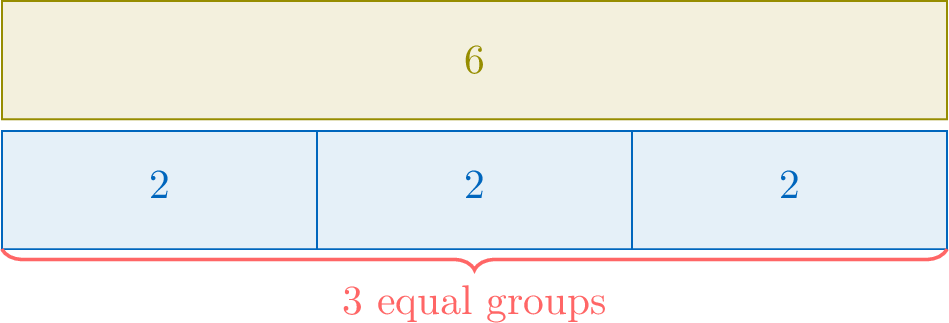

Commutative
Two brothers, Hugo and Louis, want to count the number of cubes:

- Louis calculates \(\textcolor{colordef}{2}\times \textcolor{colorprop}{3}\) to find the number of cubes.
- Hugo calculates \(\textcolor{colordef}{3}\times \textcolor{colorprop}{2}\) to find the number of cubes.
- Only Hugo
- Only Louis
- Both Hugo and Louis
Both are correct:
- Louis counts \(\textcolor{colordef}{2}\) groups of \(\textcolor{colorprop}{3}\):
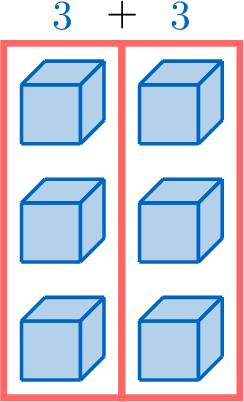
- Hugo counts \(\textcolor{colordef}{3}\) groups of \(\textcolor{colorprop}{2}\):
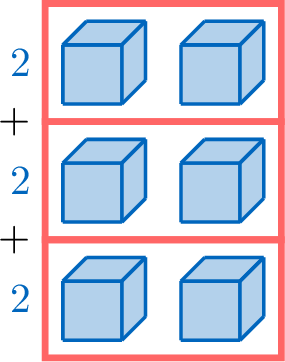
Proposition Commutative
